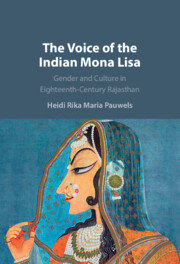Book contents
- The Voice of the Indian Mona Lisa
- The Voice of the Indian Mona Lisa
- Copyright page
- Contents
- Figures
- Acknowledgments
- Note on the Text
- Abbreviations
- Introduction
- 1 The Making of the “Indian Mona Lisa”
- 2 The Queen and the Slave Girl
- 3 Becoming the Prince’s Concubine
- 4 Synergies of the Literary Couple
- 5 Legacy: Self-Fashioning and Its Limits
- Conclusions
- Appendix: Sources
- References
- Index
Introduction
Published online by Cambridge University Press: 17 August 2023
- The Voice of the Indian Mona Lisa
- The Voice of the Indian Mona Lisa
- Copyright page
- Contents
- Figures
- Acknowledgments
- Note on the Text
- Abbreviations
- Introduction
- 1 The Making of the “Indian Mona Lisa”
- 2 The Queen and the Slave Girl
- 3 Becoming the Prince’s Concubine
- 4 Synergies of the Literary Couple
- 5 Legacy: Self-Fashioning and Its Limits
- Conclusions
- Appendix: Sources
- References
- Index
Summary
The honor of being dubbed “Indian Mona Lisa” goes to an eighteenth-century Rajput style bust portrait featuring a lady with veil in profile. No one actually claims that this painting was modeled after Leonardo da Vinci’s famous sixteenth-century Italian one; it is rather meant as a mark of distinction for the striking painting officially known as Portrait of Radha, after a Goddess and unofficially known as “Banī-ṭhanī,” after a prince’s concubine. What are the stories behind these labels? Neutrally refering to the portrait as “Lady with Veil,” this book explores what the names expose and what they conceal. Each chapter incrementally reveals the historical flesh-and-blood woman purportedly behind the canvas, unraveling the “Indian Mona Lisa” trope, probing into the mysteries of the Goddess portrait that came to stand for eternal Rajput spirituality, and presenting the debut of the voice of the concubine, Banī-ṭhanī, as she simultaneously unveils and veils herself in poetry as in painting.
- Type
- Chapter
- Information
- The Voice of the Indian Mona LisaGender and Culture in Eighteenth-Century Rajasthan, pp. 1 - 19Publisher: Cambridge University PressPrint publication year: 2023

